Main Body
19 BEYOND PHOTONS, THE VISUAL IMAGE
p. 66
Though critical, optically sorting the rays in terms of their direction of origin and catalytically sorting photons in terms of wavelength is only the firststage in seeing the world.

We use the greatest computer on earth to process the photoreceptor impulses evoked by photons to obtain a right side up visual image consistent with our body and other information about the world.
Once we get beyond the direction and wavelength of photons, the reach to explain the picture in our head soon extends beyond our present grasp.
Here is one example:
p. 87
The effectiveness of an image (or an eye at focusing the image) can be measured in terms of how many receptors are required for its recognition.22
These 20/40 letters are twice as high and wide as those at 20/20:
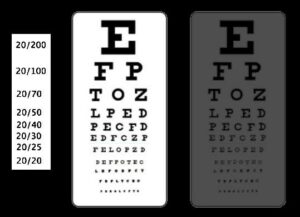
Therefore they cover 4 X as many receptors.
Decreasing the number of photons and decreasing the ratio of photons between the letters and background (contrast) increases the number of receptors needed for recognition.
However, there is more to acuity than the number of receptors and photons.
p. 68
Receptor size would seem to determine the smallest distance between two lines that keeps them distinct. Yet matters are not that simple: Eye lenses are not perfectly clear, and the rays must pass through other cells in the retina before reaching the receptors.6 This scatters the photons so their images overlap.
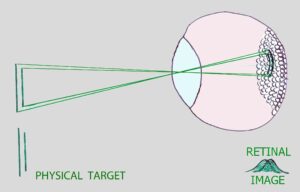
Nevertheless visual testing reveals that two lines can be distinguished even though their images are closer than the width of a receptor cell.
Clues that there is more involved than the photons’ effect on each receptor arises from what other photons do nearby.
Lengthening the lines, changing their orientation, and adding more lines all help overcome the blurring of the retinal image.
p. 69
There is an alternative to grabbing images point by point: Images can also be described holistically in terms of multiple waves spread across the entire image (Fourier analysis).
Any pattern, no matter how complex, can be described in terms of a combination of sinusoidal waves varying in frequency, amplitude, and relative phase.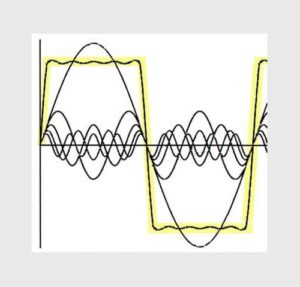
Here is how a rectangular wave can be analyzed into many sine waves:
Reversing this principle,a spatial rectangularpattern can be Fourier synthesized from several spatial waves of various frequencies:
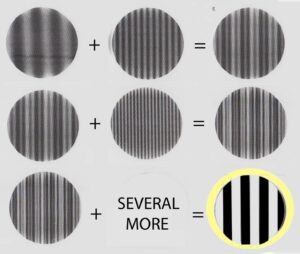
It would take hundreds of “neurons” each representing a single point to encode the information in this pattern of bars. A dozen or so “neurons” each representing a certain spatial frequency do that too.
p. 70
Any two-dimensional image (also 3-d images) can be Fourier analyzed into spatial frequency waves at various orientations. Here is the image of that room analyzed into its spatial frequency components in two dimensions:23 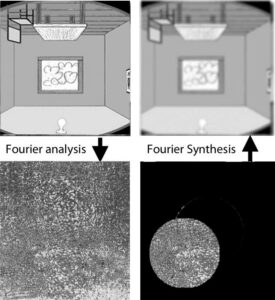
An image stored in this manner is called a hologram.Proof that the apparent randomness (it’s anything but) contains the entire image becomes evident when just a portion of the hologram is re-synthesized as shown on the right. Note that the entire image is still there – though less sharp.
Fourier analysis and resynthesis is the most efficient means of transmitting, storing, and retrieving information yet discovered.
Are you asking yourself, “What do these computer algorithms have to do with biological vision?”
This efficiency led visual systems to gradually evolve neural networks that transform images into response pathways equivalent to spatial frequencies.
p. 71
To start, the structure of our eyes makes them more sensitive to spatial frequencies around 3 cycles per degree than higher and lower ones. See for yourself:

This figure cascades a range of spatial frequencies horizontally and continuously decreases the contrast vertically.
Seeing the modulations higher up indicates greater sensitivity to that spatial frequency.
Note the decrease in contrast sensitivity at the lowest frequencies. Larger features in an image are not always more visible!
In 1969 Blakemore & Campbell published evidence of neural networks selectively tuned to various spatial frequencies in human vision.24
Here a representation of their spatial frequency tuning curves is laid over the spatial frequency sensitivity demonstration:
p. 72
Pribram (1990) further developed the theory that our image of the world is obtained by re-synthesizing the information conveyed by such spatial frequency processing.25
Here is a representation from my lectures: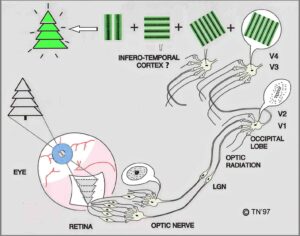
LGN is the lateral geniculate nucleus, whichrelays impulses from the optic nerve to the visual cortex.
Areas V1 & V2 and V3 & V4 are the primary and secondary areas in the occipital lobe that receive and initially process the information in those impulses.
The balloons depict what that neuron responds to best.
(The APPENDIX has a schematic brain diagram.)
p. 73
Technology enables looking both deeper and wider at the what happens in the brain as we see the image on our retina. Yet neither the ionic impulses surging through neural networks, nor the chemical soup of released neurotransmitters, nor the myriad of protein modifications within neurons would seem to be the “picture in our head”.26 While it must be the result of neurophysiology, the picture itself is not physical.Might it reside in the “dance” of 1 to 400 Hz electromagnetic radiation photons emitted by the brain? A simple version seems ruled out by Lashley’s (1951) experiments: Grounding out such fields in rat and monkey brains had little effect on their behavior.27
Nevertheless, it seems the picture must be something like a field – one yet to recognized. To speculate on where to seek further, consider how electricity was discovered. Using the technology available in the 1700’s, Galvani discovered it by studying something that was more complex than any human technology at the time – a frog. What is the 21st Century analog of a frog?
Sensory awareness is the aspect of consciousness most amenable to experimental research. While physiological probes can reveal correlations between neural activity and sensations, psychophysical methods can reveal how that activity is experienced.16 & 28 Thus seeking how activity in our brain results in a non-physiological picture may extend the Standard Model.
So much for speculation. There remains another concern about photons of more immediate usefulness:
